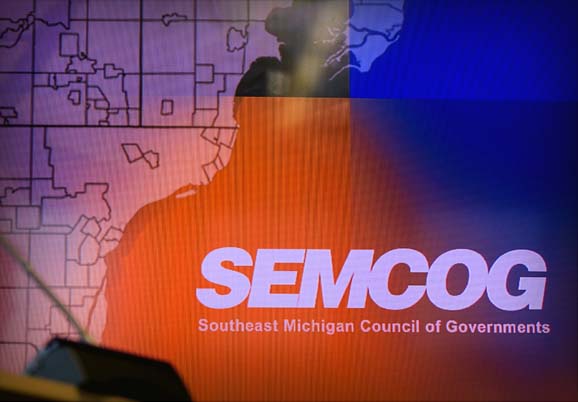DETROIT—It was a noteworthy 2013 for the Southeast Michigan Council of Governments.
The organization not only helped jumpstart the new Regional Transit Authority, but it’s been busy developing a regional non-motorized transportation plan and conducting an analysis of rapid transit alternatives along the Woodward corridor.
More controversially, SEMCOG's general assembly also approved plans for dramatic renovations of the I-94 and I-75 expressways this past summer.
None of this is new to those who closely follow the region's transportation developments, but those less versed in the group's activities might be wondering: What exactly is SEMCOG?
The short answer is that it's a confederation of various governmental institutions based in Livingston, Macomb, Monroe, Oakland, St. Clair, Washtenaw and Wayne Counties.
SEMCOG is metro Detroit's MPO. This designation means that it's been chosen by the federal government as the area's transportation policy-making organization and serves as the channel through which federal money flows into regional transportation programs.
Membership is open to all counties, cities, villages, townships, school districts, community colleges and universities in this seven-county area of southeast Michigan. Altogether, the association represents 4.7 million people in one of the larger metropolitan areas in the country.
"SEMCOG is generically known as a regional planning agency, and that means they do a lot of things," says Joe Grengs, associate professor of Urban and Regional Planning at the University of Michigan. "They're a voluntary organization. They deal with issues of a regional nature, which mainly consists of infrastructure, transportation, public transportation and land use."
In practice, the organization's work involves collecting and analyzing data, bringing together local elected officials and helping them make informed decisions.
All of this is geared towards encouraging regional cooperation, engaging in sensible long-term planning, and putting in place state and federal programs that make the best use of public funding.
One of SEMCOG’s most important functions is to act as the region's metropolitan planning organization.
This designation means that it's been chosen by the federal government as the area's transportation policy-making organization and serves as the channel through which federal money flows into regional transportation programs.
Federal and state money for the design, maintenance, preservation and rebuilding of infrastructure like roads, bridges and public transit systems is directed by a long-range plan known as the Transportation Improvement Program, or TIP.
SEMCOG's approval of the Michigan Department of Transportation’s plans to renovate and expand I-94 and I-75 was one among many projects included in the most recent version of that plan.
The Origins of SEMCOG
SEMCOG has been handling these sorts of responsibilities for 45 years.
The organization emerged on the scene in 1968, the year following the so-called Detroit riots, an urban rebellion that still ranks among the deadliest civil disturbances in United States history.
However, according to former SEMCOG Executive Director, Paul Tait, who was just replaced this month, the timing of the two events don't have any direct correlation.
"It was well on its way to being formed prior to the riots," he told Mode Shift in an e-mail. "The formulation of SEMCOG was the result of work of a group called the Committee of 100. I believe they issued their report in 1966. Predecessor organizations that merged when SEMCOG was formed included the Detroit Metropolitan Area Planning Commission which dates back to the late 1940s and the Transportation and Land Use Study that originated in the early 1960s."
SEMCOG's arrival corresponded with a wave of of similar group that were popping up around the country in the '50s and '60s. Many of these council of governments, like SEMCOG, later morphed into metropolitan planning organizations.
"The concept of MPOs began in the early 1960s with the federal government funding regional transportation and land use studies," said Tait. "The federal government recognized that local elected officials knew their regions better than the federal government."
The Detroit Metropolitan Regional Transportation and Land Use Study began in 1965 and paved the way for SEMCOG to receive its federal MPO status in 1974.
As all this was happening, the region as a whole was undergoing a major demographic shift.
During the last 60 years, Detroit experienced a dramatic population exodus, declining from roughly 1.85 million people in 1950 to 713,777 in 2010, according to U.S. census figures.
White residents, in particular, left the city in droves for the suburbs. While racial attitudes no doubt played a part in this change, it was also fueled by public policy like the building of freeways and practices like housing discrimination.
Over time the region's white and affluent populations moved further and further away from the region's historical core. Ultimately this left the city of Detroit with a population that was poorer and had more black residents than surrounding communities. As a result, southeast Michigan has become one of the most segregated regions in the country.
MOSES Inc. v. Southeast Michigan Council of Governments
Concern over the impact of these demographic trends eventually landed SEMCOG in court.
In 2003, the faith-based social justice coalition Metropolitan Organizing Strategy Enabling Strength along with the transportation advocacy group Transportation Riders United, the City of Ferndale and other plaintiffs filed a racial discrimination lawsuit with the state Court of Appeals against the MPO.
The suit alleged that SEMCOG's voting structure, a slightly modified one-government one-vote setup, discriminated against the majority black population of Detroit. For example, the City of Detroit, with a population of over 900,000 at that time, had three delegates on SEMCOG's Executive Committee, while Livingston County with a population of less than 200,000 had four.
The plaintiffs also claimed that this imbalance meant that the MPO unfairly favored directing federal funds to road maintenance over mass transit. Professor Grengs served as an expert witness for the plaintiffs at the trial.
"Something like 75 percent of all African Americans in the MPO region lived in the central city and we were seeing that the central city was not well represented," he told Mode Shift. "As a result of this bias in voting [the plaintiffs] were worried about public transit being underfunded, because the far flung suburbs tend not [to] care about transit as much as the big cities."
The court, however, decided against the plaintiffs, noting that because the City of Detroit had chosen to stay out of the case and ruling, it lacked standing.
"The MOSES lawsuit claimed that SEMCOG, with its transportation decision-making, was in fact, a government and subject to one person/one vote proportional representation," said Tait. "SEMCOG successfully argued that it does not have any traditional governmental functions like collecting taxes and providing core services like police, fire, garbage collection, etc. and, therefore, was not subject to proportional voting."
He believes that the lawsuit was "not constructive" and delayed "the implementation of the two-tier voting [system currently in place], and the equity they sought, for a couple years."
The voting system SEMCOG now uses is broken into two parts: the first uses a modified one-government one-vote setup, and the second bases representatives on population. A measure needs to win both votes to succeed. If it fails one, the motion dies, though this is a turn-of-events that has so far never happened.
In contrast to Tait, TRU's Executive Director Megan Owens believes that the lawsuit helped spark much-needed change and discussion.
"[It] helped draw attention to the disproproportionate influence of the more rural outer suburbs over the urban core," she said. "And due to that and other pressure, while SEMCOG never acknowledged their fault, they did change their voting structure to now ensure both a population-weighted vote and a one-municipality one-vote structure," she said. "While that doesn't completely resolve the challenge of urban needs in a seven-county region, it was an important step forward."
Joel Batterman, policy coordinator for MOSES, thinks the most significant outcome of the suit is the issues it raised.
"I think the key point is that we still need to be asking the same questions asked in the lawsuit," he told Mode Shift. "Why doesn't our regional government follow a rule of one-man, one-vote? For that matter, why haven't most of us ever heard of the organization that makes decisions about how and where to spend billions of dollars of taxpayer money, in ways that decisively shape the future of our communities and our region as a whole?
"And, why do those decisions continue to disadvantage older cities, poor people, and people of color, while contributing to sprawling development on the fringes of the region, even as parts of the inner city revert to farmland?" Batterman asks.
SEMCOG's Legacy
Although the organization voting procedure has changed, friction between the region's core and outlying communities persists. This was very much on display at a recent Royal Oak City Commission meeting on a SEMCOG-approved state plan to widen I-94 and I-75:
Concerned about the how the I-75 project would increase sprawl and drain city finances, Commissioner Peggy Goodwin remarked, "If you choose to live north of M-59 and to commute to Detroit, I think that's a lifestyle choice, but I don't think our community should have to sacrifice because of somebody's lifestyle choice."
In evaluating SEMCOG's legacy, Megan Owens raised similar concerns.
"I would say that SEMCOG has certainly played an important role in coordinating the transportation projects and certain air-quality and water-quality projects," she said. "Unfortunately they have not lived up to their potentional in providing true regional leadership on planning the future that we want to see. They have been overly concerned, in my opinion, about not offending any of their municipal members or stakeholders, especially in the outer rural areas and areas that are more dependent on sprawl for their growth."
Professor Grengs also criticized how the growth of Metro Detroit's expressways has impacted the region's urban core.
"It has actually quite unusual job sprawl and that is largely a function of what’s taken place," he said. "Not only has it allowed movement out of the central city of jobs and schools and retail and everything else that flows out, but it's also really cut up. It causes a lot of vacillation within the cities because of all of the freeways."
Grengs praises the work SEMCOG has done collecting and reporting data, but he’s less generous in his appraisal of the organization’s regional stewardship.
"I think that transit in this region is nothing short of flat out shameful, and I don't mean to say SEMCOG is entirely responsible for this, but they had a role in this they have not stepped up and been the kind of leaders that other regional planning agencies have been in San Francisco in Washington, Minneapolis, Portland and other places," he said. "SEMCOG doesn't see its role as stepping in, but they've opted not to step in with really harmful results.”
Tait, in turn, thinks placing too much blame for southeast Michigan’s economic and racial segregation on transportation policy is “simplistic and incorrect."
"Yes, building the freeway system helped people move out of the city and a more robust transit system may have helped reverse that trend. However, federal housing mortgages, auto manufacturing jobs that afforded home ownership, cross district busing for schools, housing redlining practices, and a whole host of other factors contributed to that disparity."
He also points out that SEMCOG has "aggressively advocated" for the establishment of southeast Michigan's new—but unfunded—RTA, and has provided staff and other support to help it get off the ground.
In recent years, he adds, SEMCOG has efficiently managed regional road repairs with declining revenues and encouraged addressing transportation issues with "low-cost solutions" like ridesharing, telecommuting, better traffic signals and enhanced intersection design.
Tait is hopeful as well about SEMCOG's recent 2040 Regional Transportation plan, which he said contains strategies to promote "economic prosperity and accessibility to jobs and other amenities" in the region.
However, as the recent hubub over proposed freeway widenings and the recent resignation of the RTA's chief executive shows, consensus over the region's transportation future is far from universal, and the fruits of SEMCOG's newest plan, bitter or sweet, will be difficult to completely grasp for many years to come.
Do you think SEMCOG is doing more to help or hinder progress in southeast Michigan? Share your thoughts in the comments below.










